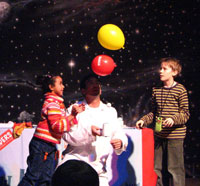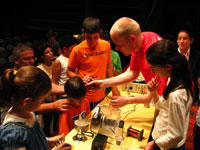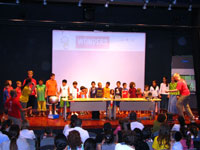Second European Science Festival: WONDERS 2007 Inspire article
Peter Rebernik from the WONDERS project describes a ride in the Carousel of Science from Moscow to Lisbon, Reykjavik to Jerusalem. Perhaps even in your town!

Rebernik
French science shows in Estonia; Swedish science theatre in Sofia, the capital of Bulgaria; mechanics designed by the Catalan architect Gaudí demonstrated in Budapest; mathematical balls travelling from Perugia, Italy, to Reykjavik, Iceland – what kind of a carousel is that? It is WONDERS!
WONDERS, the first European Science Festival, came to an end at the Heureka science centre, Finland, in December 2006. Over the course of the year, 21 science organisations from 18 countries exchanged an impressive 63 science shows. Among many other exciting activities, visitors could cycle at the speed of light, track a white stork using a satellite, or isolate DNA from tomatoes in the kitchen. From all those science shows, two of the best science communication presentations were chosen in the Finnish finals.
The jury’s favourite was ‘Dr Molecula’, a lively science show from the Bloomfield Science Museum in Jerusalem, Israel. “When you combine theatre and science, the result is really moving,” says Ori Weyl, alias Dr Molecula. “I was the worst science student myself, so I know that if I understand the things I am performing, the audience will understand it too!”

Rebernik
“Dr Molecula really showed how the language barrier becomes irrelevant when the performance is such fun and so vivid,” says a jury member, Finnish high-school student Roosa Jokiaho.
The Finnish audience selected Joachim Lerch’s ‘Blue Light’ project, a simulated factory from Germany in which visitors could assemble their own flashlights. Both adults and children were taught how to drill, countersink, tap, punch, solder, band, assemble, rivet and adhere.
Science shows are lively presentations by scientists, students, teachers and pupils, who communicate science through direct contact with the audience; volunteers are invited to join in, visitors to science cafés can discuss topics with scientists in the field, pupils can shout and scream at scary experiments. Most shows are just 15 minutes; some last 45 minutes including discussion. Visitors go from show to show, to experience the breadth of science. And most shows take place in public places: railway stations, shopping malls, tents on the main square, and so forth.

Rebernik
All the science shows in the Carousel of Science try to stimulate the interest of European citizens in science, encouraging them to become more curious about European science and, in the case of young spectators, to think about a future science career.
The science shows are organised by the science communication institutions of the participating countries and are sent to each other during their science festivals or science weeks. In that way, not only do the visitors to this ‘foreign’ show learn something in an amusing way, but also the hosting organisation can experience how other countries conduct their science shows.
In 2007, the second European Science Festival, WONDERS 2007, will see 31 organisations from 24 states participate in the Carousel of Science, exchanging science shows between cities as distant as Moscow and Lisbon, Reykjavik and Jerusalem. The Estonian university town of Tartu, for example, will send scientists to the Greek city of Thessaloniki, while the Greek researchers will in turn go to Madrid, Spain. Why not join the dizzying ride?
Resources
- EUSCEA, the European Science Events Association, is the co-ordinator of this project, the European Commission is funding it, and the partners in 2007 are the European Schoolnet and EUSJA, the European Union of Science Journalists’ Associations.
- For more information about WONDERS and to find out about science shows in your country, see: www.euscea.org





